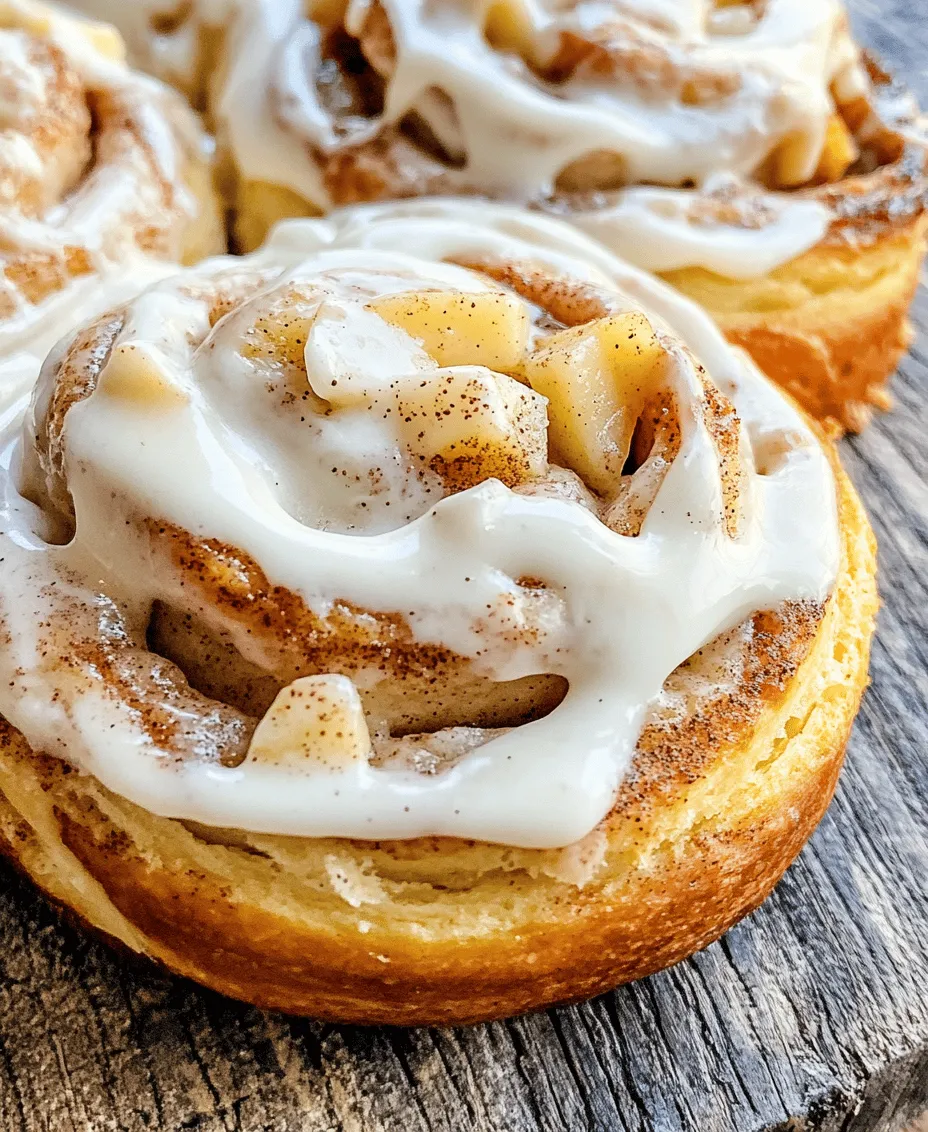Introduction
There’s something truly magical about the aroma of freshly baked goods wafting through your home, capturing the essence of comfort and joy. Homemade treats not only satisfy our taste buds but also evoke cherished memories of family gatherings and cozy mornings. Among the myriad of baked delights, apple cinnamon rolls stand out as a quintessential favorite—perfectly fluffy, swirled with a luscious cinnamon-sugar filling, and topped with a rich cream cheese frosting.
The irresistible combination of sweet apples and aromatic cinnamon elevates these rolls beyond the ordinary. The tartness of crisp apples, when paired with warm, fragrant cinnamon, creates a delectable contrast that excites the palate. Topping it all off with creamy, tangy frosting adds an indulgent finish that will have everyone coming back for seconds.
In this article, we will explore the rich history of cinnamon rolls, delve into the unique benefits of adding apples, and provide a detailed guide to crafting your own batch of these delightful treats. You will also find a breakdown of ingredients and a step-by-step process to ensure your apple cinnamon rolls turn out perfectly every time.
The Appeal of Apple Cinnamon Rolls
Historical Background of Cinnamon Rolls
Cinnamon rolls have a long and delicious history that dates back to the early 18th century. Originating in Sweden, these sweet pastries were known as “kanelbullar,” which translates to “cinnamon buns.” They quickly gained popularity across Europe and eventually made their way to the United States, where they became a breakfast staple and a beloved dessert.
While traditional recipes often focus on the simple combination of dough, sugar, and cinnamon, the introduction of fruity fillings like apples enhances both flavor and texture, providing a delightful twist to the classic. The melding of warm spices and fresh fruit creates a symphony of flavors that captivates the senses.
Why Apples Enhance the Flavor and Texture of Traditional Rolls
The addition of apples to cinnamon rolls is not just a matter of flavor; it’s about creating a multi-dimensional taste experience. Apples bring natural sweetness and a hint of acidity, balancing the richness of the dough and the spiciness of cinnamon. Their moisture content also contributes to a softer, more tender roll, making each bite a pleasurable experience.
Different varieties of apples can also influence the overall character of your rolls. For example, tart Granny Smith apples provide a refreshing contrast to the sweet, gooey filling, while Honeycrisp apples offer a sweeter, juicier bite. The choice of apple can significantly affect the final result, allowing you to customize your rolls to your personal taste.
The Popularity of Cinnamon Rolls in Different Cultures
Cinnamon rolls are beloved in various forms around the globe. In addition to the Swedish kanelbullar, you will find similar pastries in Germany, known as “schnecken,” which often include nuts and dried fruits. In the United States, cinnamon rolls are frequently associated with breakfast diners and holiday brunches, often served warm from the oven.
This widespread popularity speaks to the universal appeal of soft, sweet rolls that are perfect for sharing. The addition of apples not only enhances the flavor profile but also taps into the comforting nostalgia that comes with enjoying homemade baked goods, making apple cinnamon rolls a favorite among many different cultures.
Ingredients Breakdown
Creating the perfect apple cinnamon rolls requires careful selection of ingredients, each playing a vital role in the overall outcome. Let’s break down the essential components that come together to form these irresistible treats.
Overview of the Essential Ingredients
For our apple cinnamon rolls, we will need:
– All-purpose flour
– Instant yeast
– Milk
– Sugar (granulated and brown)
– Eggs
– Butter
– Cinnamon
– Apples
– Cream cheese (for frosting)
Each ingredient is crucial in contributing to the flavor, texture, and overall success of the rolls.
Flour: Types and Importance in Dough
The foundation of any good roll is flour. All-purpose flour is the most commonly used type in baking and strikes a balance between protein content and versatility. For apple cinnamon rolls, a blend of all-purpose and bread flour can also be used to achieve a chewier texture, thanks to the higher protein content in bread flour.
When measuring flour, it’s essential to do so accurately. Too much flour can result in dense rolls, while too little can lead to overly sticky dough. The best method is to spoon the flour into a measuring cup and level it off with a straight edge.
Yeast: Role of Instant Yeast and Rise Time
Yeast is the magic ingredient that causes the dough to rise, creating those characteristic fluffy rolls. For this recipe, we will be using instant yeast, which is preferred for its ease of use and quick activation. Unlike active dry yeast, instant yeast does not require proofing, meaning you can mix it directly into your dry ingredients.
The rise time is equally important. Allowing the dough to rise in a warm, draft-free environment helps it to develop flavor and texture. The first rise will give the dough volume, while the second rise after shaping allows for those lovely air pockets that make the rolls light and fluffy.
Milk: The Significance of Temperature
Milk is another key ingredient that enriches the dough, providing moisture and flavor. The temperature of the milk is crucial; it should be warm (around 110°F or 43°C) but not hot. If the milk is too hot, it can kill the yeast, while cold milk will slow down the activation process.
Using whole milk or a milk alternative adds creaminess to the dough, enhancing the overall richness of the rolls.
Sugar: Different Types and Their Effects on Flavor
Sugar serves multiple purposes in this recipe. It sweetens the dough and filling, aids in browning, and helps with moisture retention. For our apple cinnamon rolls, we will use both granulated sugar and brown sugar.
Granulated sugar is commonly used in the dough, while brown sugar, with its molasses content, deepens the flavor of the filling. The combination of both sugars creates a balanced sweetness that complements the apples and cinnamon beautifully.
Filling Ingredients
The filling for our apple cinnamon rolls includes:
– Brown sugar
– Ground cinnamon
– Apples
The blend of brown sugar and cinnamon forms a warm, sweet mixture that pairs perfectly with the tartness of the apples. When choosing apples, it’s important to select varieties that hold up well during baking to maintain their texture.
Choosing the Right Apples: Granny Smith vs. Honeycrisp
Selecting the right apples is crucial for achieving the perfect flavor and texture in your rolls. Granny Smith apples are a popular choice due to their tartness, which provides a refreshing contrast to the sweet filling. Their firm texture holds up well during baking, ensuring that they don’t turn mushy.
On the other hand, Honeycrisp apples offer a sweeter profile and a juicy crunch, making them an excellent alternative for those who prefer a sweeter roll. Depending on your personal preference, you can even mix both varieties for a delightful medley of flavors in your rolls.
The Role of Brown Sugar and Cinnamon in Flavor Enhancement
Brown sugar and cinnamon are the heart of the filling. Brown sugar, with its rich, caramel-like flavor, enhances the warmth of the cinnamon. Together, they create a comforting and nostalgic flavor that is synonymous with homemade cinnamon rolls.
Cinnamon, known for its aromatic qualities, not only adds sweetness but also contributes warmth and depth to the rolls. The combination of these two ingredients results in a filling that is both flavorful and fragrant, enveloping the apples in a delightful embrace.
Frosting Ingredients
No cinnamon roll would be complete without a luscious frosting. For our cream cheese frosting, we will need:
– Cream cheese
– Powdered sugar
– Vanilla extract
– Milk (to achieve desired consistency)
Cream cheese adds a tangy flavor that balances the sweetness of the rolls, while powdered sugar provides the necessary sweetness and smooth texture. A splash of vanilla extract enhances the overall flavor, making each bite even more delicious.
Importance of Cream Cheese in Creating the Perfect Texture
Cream cheese is the star of the frosting, contributing to its rich and creamy texture. By using softened cream cheese, you can achieve a smooth consistency that spreads easily over the warm rolls.
The addition of milk allows you to adjust the frosting’s thickness, ensuring that you can achieve your desired consistency. Whether you prefer a thicker frosting that holds its shape or a thinner glaze that drizzles beautifully, cream cheese is essential for that mouthwatering finish.
Variations in Frosting Consistency Based on Milk Usage
The amount of milk you add to your cream cheese frosting can significantly impact its texture. For a thicker frosting, use less milk, which will hold its shape well when piped onto the rolls. Conversely, if you prefer a glaze-like consistency, simply add more milk until it reaches your desired thickness.
By experimenting with milk quantities, you can customize the frosting to suit your preferences, whether you want a generous layer on top or a light drizzle that enhances the rolls without overpowering them.
Step-by-Step Instructions for Making Apple Cinnamon Rolls
Preparing the Dough
Now that we have a clear understanding of our ingredients, it’s time to dive into the step-by-step instructions for making the dough for our apple cinnamon rolls.
1. Activate the Yeast: In a small bowl, combine warm milk (110°F or 43°C) with a teaspoon of granulated sugar. Sprinkle the instant yeast over the milk and let it sit for about 5 minutes. You should see bubbles forming, indicating that the yeast is activated.
2. Mix the Dry Ingredients: In a large mixing bowl, combine 4 cups of all-purpose flour, 1/4 cup of granulated sugar, and 1 teaspoon of salt. Whisk together until well incorporated.
3. Combine Wet and Dry Ingredients: Once the yeast mixture is frothy, pour it into the dry ingredients. Add 1/4 cup of melted butter and 1 egg. Mix with a wooden spoon or spatula until a shaggy dough forms.
4. Knead the Dough: Transfer the dough onto a floured surface and knead for about 8-10 minutes until it becomes smooth and elastic. If the dough is too sticky, add a little more flour, but be careful not to add too much.
5. First Rise: Place the kneaded dough in a greased bowl, cover it with a damp cloth or plastic wrap, and let it rise in a warm place for about 1 hour or until it has doubled in size.
Detailed Explanation of Activating Yeast
Activating yeast is a crucial step in the bread-making process, as it ensures that the yeast is alive and capable of fermenting the sugars in the dough. When the yeast is combined with warm liquid and sugar, it begins to feed on the sugars, producing carbon dioxide bubbles. This process is what causes the dough to rise and develop a light, airy texture.
It’s essential to use water or milk that is warm but not hot. If the liquid is too hot, it can kill the yeast, preventing it from activating. Conversely, if the liquid is too cold, the yeast will not activate effectively, leading to a dense roll.
By allowing the yeast to sit for a few minutes until it becomes frothy, you can ensure that it is active and ready to work its magic in your dough. This simple step is fundamental for achieving the fluffy texture we all love in cinnamon rolls.
Stay tuned for the next part, where we will continue our journey by preparing the filling, shaping the rolls, and baking them to perfection!

Mixing Techniques for a Soft, Elastic Dough
Achieving the perfect dough for your apple cinnamon rolls begins with the right mixing techniques. When combining your ingredients, start by mixing the dry ingredients—flour, sugar, salt, and yeast—in a large bowl. This ensures that the yeast is evenly distributed throughout the flour, which is crucial for proper rising.
Next, in a separate bowl, whisk together your wet ingredients—milk, melted butter, and eggs. Gradually add the wet mixture to the dry ingredients, stirring until they start to come together. Avoid overmixing; the goal is to combine until the ingredients are just incorporated.
Once combined, it’s time to knead. This process develops the gluten in the flour, giving the rolls their characteristic soft and elastic texture.
Tips for Kneading the Dough Effectively
Kneading dough is an essential step that shouldn’t be rushed. Here are some effective tips to ensure your dough reaches the right consistency:
1. Use a Clean Surface: Lightly flour your countertop or a large cutting board. This prevents sticking and makes kneading easier.
2. Knead by Hand: Using the heel of your hand, push the dough away from you, fold it over, and rotate it a quarter turn. Repeat this motion for about 8-10 minutes. The dough should become smooth and elastic.
3. Monitor the Texture: If your dough feels sticky, sprinkle in small amounts of flour until it’s manageable. Conversely, if it’s too dry, add a few drops of water or milk.
4. Check for Windowpane: To test if your dough is sufficiently kneaded, stretch a small piece between your fingers. If it forms a thin, translucent membrane without tearing, you’re ready to let it rise.
Making the Filling
The filling is where the magic happens, transforming your simple rolls into a burst of flavor. Follow these steps to create the perfect apple cinnamon filling:
Preparing Apples: Peeling and Dicing Tips
Start with fresh, tart apples such as Granny Smith for a balance of sweetness and tartness. Here’s how to prepare them:
1. Peeling: Use a vegetable peeler or a paring knife to remove the skin. Make sure to remove any bruised or blemished areas.
2. Dicing: Cut the apple in half, remove the core, and slice it into quarters. Lay each quarter flat and chop into small, even cubes, ensuring they will cook evenly in the rolls.
Blending Flavors in the Filling: The Role of Sugar and Spices
In a medium bowl, combine the diced apples with brown sugar, cinnamon, and a pinch of nutmeg. Brown sugar adds moisture and depth, while cinnamon and nutmeg enhance the apple flavor. Mix until the apples are thoroughly coated. For added texture and flavor, consider mixing in chopped nuts or raisins.
Assembling the Rolls
With your dough risen and filling prepared, it’s time to assemble those irresistible rolls.
Techniques for Rolling Dough
1. Roll Out the Dough: On a floured surface, turn out your dough and gently roll it into a rectangle, about 16×12 inches. Aim for an even thickness of about ¼ inch.
2. Spread the Filling: Evenly distribute your apple filling over the rolled-out dough, leaving a small border around the edges.
Importance of Sealing the Edges for a Perfect Roll
To form the rolls, start from the long edge of the rectangle and carefully roll the dough tightly away from you. This ensures that your filling stays intact. Once rolled, pinch the seams to seal and prevent any filling from leaking out during baking.
Proofing and Baking
Understanding the Second Rise: Why it Matters
After assembling the rolls, place them in a greased baking dish. Cover with a clean kitchen towel and let them rise for about 30-45 minutes in a warm spot. This second rise allows the rolls to become fluffy and light, making them more enjoyable.
How to Achieve the Perfect Golden-Brown Finish
Preheat your oven to 350°F (175°C). Bake the rolls for 25 to 30 minutes, or until they’re golden brown and the center feels set. If the tops brown too quickly, cover them loosely with aluminum foil to prevent burning.
Creating the Cream Cheese Frosting
A luscious cream cheese frosting elevates your apple cinnamon rolls to a new level of indulgence.
Mixing Techniques for a Smooth Frosting
In a mixing bowl, combine softened cream cheese and unsalted butter. Beat them together with an electric mixer until smooth and creamy. Gradually add powdered sugar and a dash of vanilla extract. Mix until fully incorporated.
Adjusting Consistency: When and How to Add Milk
If your frosting is too thick, add milk one tablespoon at a time until you reach your desired consistency. The frosting should be spreadable but not too runny, allowing it to hold its shape once applied to the rolls.
Flavor Variations: Suggestions for Enhancing the Frosting
For a twist, consider adding different flavors to your frosting. A pinch of cinnamon can complement the rolls beautifully. For a hint of citrus, add a bit of lemon or orange zest. Experiment and find your favorite combination!
Serving Suggestions and Pairings
Best Times to Enjoy Apple Cinnamon Rolls
Apple cinnamon rolls are perfect for breakfast, brunch, or as a delightful afternoon treat with coffee. They can also make an excellent dessert for any gathering.
Pairing Ideas: Beverages and Side Dishes that Complement the Rolls
Consider serving your rolls with warm apple cider or a rich cup of coffee. For a more indulgent option, pair them with hot chocolate or a chai latte. If you’re looking for side dishes, a simple fruit salad or yogurt can balance the sweetness.
Storing and Reheating Tips for Freshness
To store your rolls, place them in an airtight container at room temperature for up to three days. If you want to keep them longer, refrigerate them for up to a week. To reheat, simply warm them in the microwave for 15-20 seconds or pop them in the oven at 350°F (175°C) for about 10 minutes.
Nutritional Information
Overview of Calories and Macronutrients Per Serving
Each apple cinnamon roll contains approximately 300 calories, with 10g of fat, 45g of carbohydrates, and 4g of protein. Keep in mind that these values can vary based on the specific ingredients used and portion sizes.
Discussion of Ingredient Substitutions for Dietary Preferences
For a healthier option, you can substitute whole wheat flour for all-purpose flour, and use coconut oil instead of butter for a dairy-free version. You can also use a sugar alternative like coconut sugar or a stevia blend to reduce calories while still enjoying the delightful flavors.
Conclusion
Baking apple cinnamon rolls is not just about creating a delicious treat; it’s about embracing the joy of cooking and the warmth of homemade goodness. As you create these delightful rolls filled with sweet apples and fragrant spices, you’re also crafting memories that can be cherished for years to come.
We encourage you to try this recipe at home and share the experience with family and friends. The satisfaction of pulling a warm tray of apple cinnamon rolls from the oven, topped with luscious cream cheese frosting, is unparalleled. Homemade treats carry a special kind of love, and there’s nothing quite like the aroma of freshly baked goods filling your kitchen. Enjoy this timeless recipe, and let it become a cherished part of your culinary traditions.



